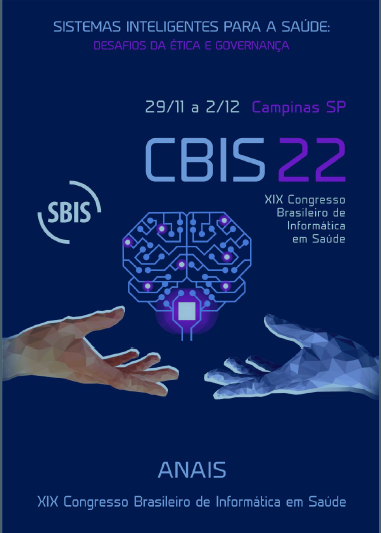Identificação da Doença de Alzheimer Através da Fala Utilizando Reconhecimento de Emoções
DOI:
https://doi.org/10.59681/2175-4411.v15.iEspecial.2023.1093Keywords:
Alzheimer Disease, Automatic Speech Analysis, Machine LearningAbstract
Alzheimer's disease is the most common neurodegenerative dementia in elderly people in the world and its diagnosis requires a wide medical evaluation, supported by cognitive tests, clinical and imaging exams. Identifying the disease through speech can reduce the cost and time of medical diagnosis. Emotional states are important performance indicators of cognitive processes. Intelligent and non-invasive computational techniques can become relevant support tools for an early medical diagnosis. Therefore, this article addresses the use of emotion recognition through voice as a biomarker to identify the presence of Alzheimer's disease. The proposed method is based on the extraction of emotional features from speech and pattern recognition using neural networks. The results of the experiments reached an accuracy of 72.61%, a precision of 72.90% and a recall of 72.50% through cross-validation of the data.
References
who.int [Internet]. Ageing - World Health Organization; c2022 [cited 2022 Aug 27]. Available from: https://www.who.int/health-topics/ageing.
Gauthier S, Webster C, Servaes S, Morais JA, Rosa-Neto P. World Alzheimer Report 2022: Life after diagnosis: Navigating treatment, care and support. London, England: Alzheimer’s Disease International (ADI); 2022.
Vizza P, Tradigo G, Mirarchi D, Bossio RB, Lombardo N, Arabia G, et al. Methodologies of speech analysis for neurodegenerative diseases evaluation. International Journal of Medical Informatics. 2019 Feb;122:45–54.
Alzheimer's Association. 2022 Alzheimer's Disease Facts and Figures. Chicago: Alzheimer's Association; 2022.
Liu L, Zhao S, Chen H, Wang A. A new machine learning method for identifying Alzheimer’s disease. Simulation Modelling Practice and Theory. 2020 Feb;99:102023.
Sharma P, Sharma A, Fayaz F, Wakode S, Pottoo FH. Biological signatures of Alzheimer Disease. Current Topics in Medicinal Chemistry. 2020 Apr 1;20.
Pulido MLB, Hernández JBA, Ballester MÁF, González CMT, Mekyska J, Smékal Z. Alzheimer’s disease and automatic speech analysis: A review. Expert Systems with Applications. 2020 Jul 15;150:113213.
Haider F, de la Fuente S, Albert P, Luz S. Affective Speech for Alzheimer’s Dementia Recognition. In Kokkinakis D, Lundholm Fors K, Themistocleous C, Antonsson M, Eckerström M, editors, LREC: Resources and Processing of linguistic, para-linguistic and extra-linguistic Data from people with various forms of cognitive/psychiatric/developmental impairments (RaPID). European Language Resources Association (ELRA). 2020. p. 67-73
de la Fuente Garcia S, Haider F, Luz S. Cross-corpus Feature Learning between Spontaneous Monologue and Dialogue for Automatic Classification of Alzheimer’s Dementia Speech. 2020 42nd Annual International Conference of the IEEE Engineering in Medicine & Biology Society (EMBC). 2020 Jul 20-24; Montreal, Canada. p. 5851-5855
Campbell EL, Mesía RY, Docío-Fernández L, García-Mateo C. Paralinguistic and linguistic fluency features for Alzheimer’s disease detection. Computer Speech & Language. 2021 Jul;68:101198.
Burkhardt F, Paeschke A, Rolfes M, Sendlmeier WF, Weiss B. A database of German emotional speech. In: Ninth European Conference on Speech Communication and Technology; 04-08 de setembro de 2005; Lisboa, Portugal. INTERSPEECH 2005. p. 1517-1520.
Becker JT, Boiler F, Lopez OL, Saxton J, McGonigle KL. The natural history of Alzheimer's disease: Description of study cohort and accuracy of diagnosis. Archives of Neurology. 1994 Jun; 51 (6): 585-594.
Husein Z. Malaya, Speech-Toolkit library. Version 1.2.7 [software]. 2020 [cited 2022 Aug 27]. Available from: https://github.com/huseinzol05/malaya-speech.
Wagner J, Triantafyllopoulos A, Wierstorf H, Schmitt M, Eyben F, Schuller BW. Dawn of the transformer era in speech emotion recognition: closing the valence gap. arXiv:2203.07378v2 [Preprint]. 2022 [cited 2022 Aug 27]: [25 p.]. Available from: https://arxiv.org/abs/2203.07378v2
Braga AC, Oliveira P. Diagnostic analysis based on ROC curves: theory and applications in medicine. International Journal of Health Care Quality Assurance. 2003 Jul 1. p. 191-198.
Downloads
Published
How to Cite
Issue
Section
License
Copyright (c) 2023 Guilherme Bernieri, Julio Cesar Duarte

This work is licensed under a Creative Commons Attribution-NonCommercial-ShareAlike 4.0 International License.
Submission of a paper to Journal of Health Informatics is understood to imply that it is not being considered for publication elsewhere and that the author(s) permission to publish his/her (their) article(s) in this Journal implies the exclusive authorization of the publishers to deal with all issues concerning the copyright therein. Upon the submission of an article, authors will be asked to sign a Copyright Notice. Acceptance of the agreement will ensure the widest possible dissemination of information. An e-mail will be sent to the corresponding author confirming receipt of the manuscript and acceptance of the agreement.

